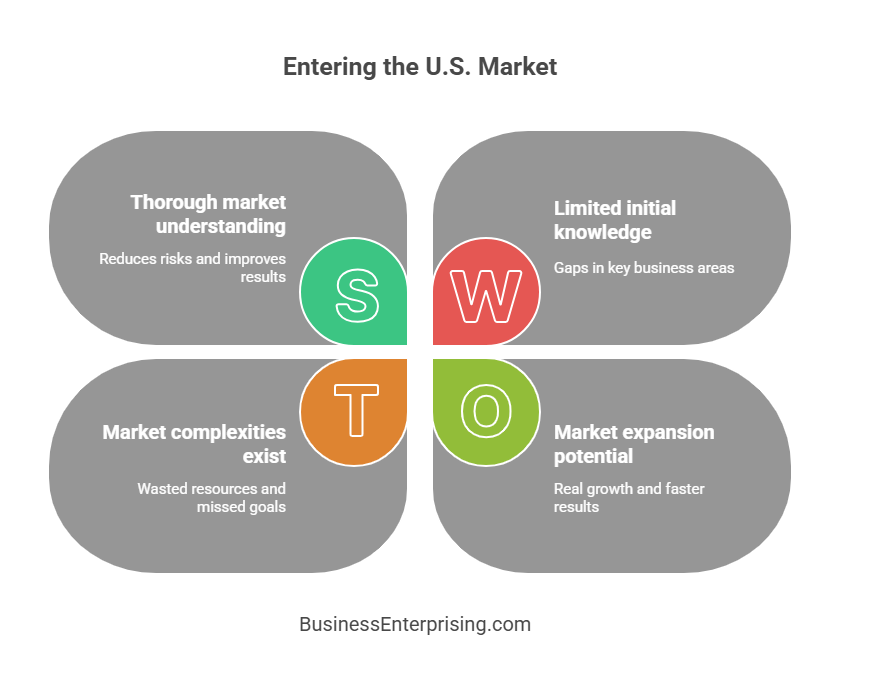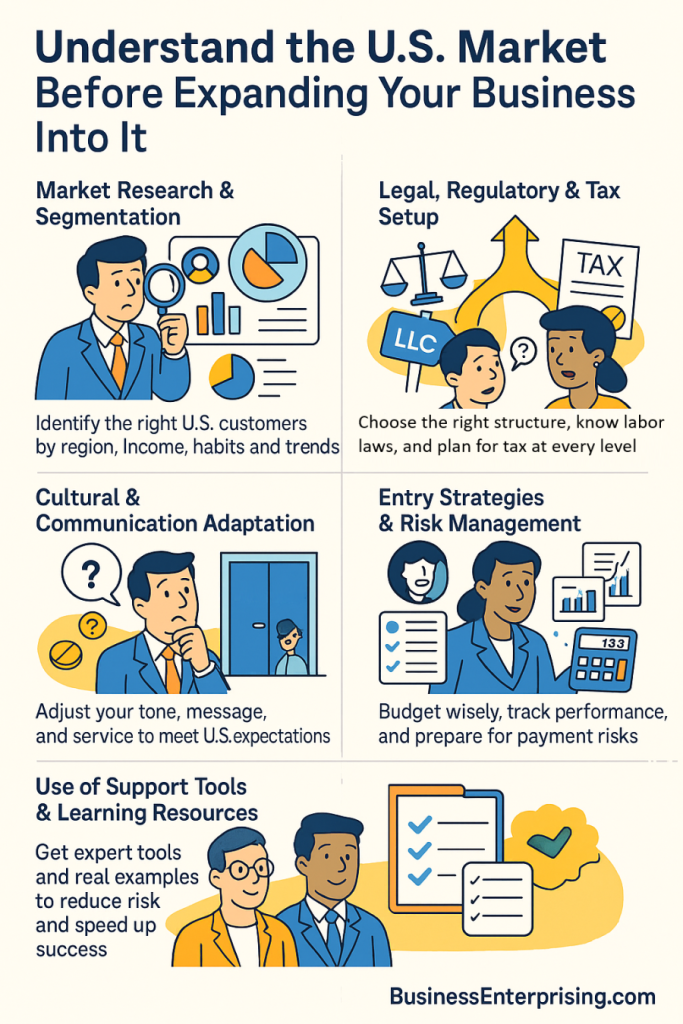
The U.S. offers opportunity, but it also brings complexity. You must learn how customers think, how laws apply, and what competitors already offer. Therefore, your decisions must come from research, not assumptions. What worked in your home market may not work here. Consumer behavior, pricing, and product demand all shift based on location.
Additionally, the structure of your business affects everything. Legal filings, taxes, and hiring all vary across states. If you skip these steps, you’ll pay more later. That’s why preparation matters. A smart plan helps you avoid surprises and respond to problems faster. It also keeps your team focused and aligned.
Support tools can help you build that plan. With checklists, case studies, and expert guidance, you’ll work more efficiently. Therefore, your launch becomes less stressful and more productive. By knowing what to expect, you lower your risk and improve your results.
You don’t need to guess your way through this. Instead, take time to study the market before you enter it. That decision alone can make the difference between success and slow failure. Use what others have learned, and build on that knowledge to move forward with purpose.
Market Research & Segmentation: Know Who You’re Selling To
Understanding who buys your product is one of the most important steps in entering a new market. You cannot succeed without clear insight into your ideal customer. Before expanding, take the time to understand the U.S. market and its many differences. The U.S. consumer base is large, but not one-size-fits-all. Preferences shift by age, income, and lifestyle. Buying habits also differ across industries and product types.
Therefore, start by reviewing customer demographics. Age groups, household income, and education levels often affect purchasing decisions. For example, younger buyers may focus on price and convenience. Older consumers may value quality and brand trust. Additionally, lifestyle plays a role. Health-conscious buyers spend differently than those who prioritize luxury or tech.
Regional habits matter, too. What works in California may not work in Texas or New York. Therefore, compare regional preferences before launching a broad campaign. The Northeast may respond to brand history and value, while the South may prefer community ties and loyalty offers. The West Coast tends to favor innovation and sustainability. These preferences affect how you market, price, and deliver your product.
You also need to research your competition. Knowing what others offer will help you position your product correctly. Pay attention to pricing, packaging, and promotions in your category. Study companies that sell to the same audience. Identify gaps you can fill or strategies that outperform the rest. Therefore, gather both customer and competitor data to guide your decisions. Without this insight, you risk spending in the wrong direction.
Use what you learn to refine your strategy. The U.S. market offers many chances, but it rewards those who prepare. Make sure you speak to the right audience, in the right way, at the right time.
Legal, Regulatory & Tax Considerations: The Rules of the Game
Before you expand your company into the United States, take time to understand how the rules differ. The U.S. has a complex legal and tax structure that can affect your setup, operations, and bottom line. If you don’t account for these details early, you may face delays or extra costs.
Start by choosing the right business structure. Many foreign companies register as an LLC or C-Corporation. Each option affects your tax obligations, reporting requirements, and liability. LLCs offer flexibility, while C-Corps may suit companies seeking outside investors. Therefore, you should evaluate which structure aligns with your goals and ownership plans.
Additionally, U.S. labor laws require careful review. You must follow rules on wages, hiring practices, overtime, and workplace safety. These laws vary from state to state, so you need to stay current. If you plan to bring products in or out of the U.S., understand customs rules and import duties. Failure to follow the right steps can hold your goods at the border.
Tax compliance includes federal, state, and local levels. Each level may require different filings and payments. Therefore, you should work from a clear checklist. Tax rates and regulations vary by location and revenue type. You’ll also need to protect your brand. Register trademarks and patents to avoid legal trouble later. Without that protection, your ideas or logos could be used by others.
To succeed, you must understand the U.S. market and how it operates. Legal and tax planning isn’t optional. It’s part of building a business that lasts. Take the time to get it right from the beginning. It will save you effort, money, and frustration later.
Cultural & Communication Adaptation: Bridging the Gap
Cultural awareness plays a major role when doing business in the U.S. You may speak the same language, but expectations differ. If you plan to sell, lead, or build teams, you need to understand how Americans prefer to work and communicate. Those habits directly affect how they receive your brand and interact with your company.
For example, customer service carries weight in U.S. business. Polite tone, prompt replies, and clear answers are expected. Customers often value speed over formality. Therefore, train your staff to respond quickly and with helpful detail. Employees should avoid vague replies or long delays. Even a short silence can lead to lost trust or sales.
Marketing also requires adjustments. Humor, tone, and images don’t always translate well. What works in one country may feel strange or confusing in another. Therefore, review your message before you go to market. Use words and symbols that match U.S. values and norms. Keep messages clear, honest, and easy to understand. Americans tend to prefer direct, benefit-focused content over abstract phrasing.
Additionally, team communication matters. Remote work is common across time zones and cultures. Clear roles, meeting schedules, and written guidelines can reduce confusion. If your team includes both local and overseas members, set shared expectations early. Address differences in communication styles before they cause friction.
To succeed long-term, you must understand the U.S. market and the people in it. That includes how they think, speak, and work. Building that awareness takes effort, but it improves every part of your business. Therefore, start early and keep adjusting as you grow.
Entry Strategy & Channels: Finding the Right Path In
How you enter the U.S. market will affect your costs, speed, and long-term control. You have multiple paths, but each one works best for a different type of business. Some companies begin with direct sales or a local distributor. Others set up a joint venture, build a physical location, or launch through e-commerce channels.
Each model carries its own tradeoffs. Direct sales offer control but require more upfront investment. Distributors lower risk but reduce your margin. Therefore, weigh your goals against your available resources. If you want speed, a partner may help. If you want brand control, a direct office may be better.
Additionally, e-commerce offers a lower barrier to entry. You can reach customers quickly without needing staff or buildings in the U.S. However, customer service, returns, and shipping still require planning. Therefore, think beyond the website. You must still manage fulfillment, taxes, and regulations across state lines.
Physical stores or offices offer more visibility but increase overhead. Rent, staffing, and inventory management become daily concerns. Therefore, this option may suit businesses with larger budgets or long-term plans. Logistics also deserve attention. The U.S. is large and spread out. Distribution networks and delivery times vary. You’ll need clear processes and strong partners to handle inventory and returns.
To succeed, you must understand the U.S. market and how buyers prefer to engage with your type of product. Entry planning isn’t one-size-fits-all. Pick the approach that matches your product, budget, and growth goals. Then build from there with steady focus and data.
Financial Planning & Risk Management: Building a Sustainable Investment Case
Expanding into the U.S. comes with financial risks, so planning matters. You need clear numbers to make confident decisions. Costs often rise faster than expected, especially during the first year. Therefore, build a detailed budget that includes setup, marketing, staffing, and compliance.
Additionally, forecasting gives you a sense of how long cash will last. Factor in exchange rates, sales cycles, and payment delays. Currency fluctuations can affect margins and pricing. Therefore, decide if you’ll accept U.S. dollars only or offer local payment options. Review your insurance needs early. Business liability, product coverage, and workers’ comp may all apply.
Regulations around taxes and payments differ across states. Some states require monthly filings, others quarterly. Therefore, confirm what applies based on your location and industry. Don’t forget recurring costs such as storage, payroll, and digital tools. You’ll also want to monitor financial performance closely.
Set clear metrics to track progress. Sales growth, customer acquisition costs, and average order value offer insight into market traction. Additionally, monitor gross margins and cash flow to avoid shortfalls. If you run out of cash, everything else stops. Therefore, use data to course-correct before problems grow.
You must understand the U.S. market to plan well and spend wisely. Guesswork will burn your budget and delay results. Take time to build a model based on real numbers. The more you control your inputs and outputs, the more likely you’ll build something that lasts.
When to Use Support Tools & Learning Resources: Why Invest in a Course Like This
Most companies enter the U.S. market with limited knowledge about what’s required. They may have a great product, but miss key steps. Common gaps include legal filings, marketing plans, sales channels, and compliance. Therefore, even experienced businesses benefit from outside support before expanding.
A structured course can fill those gaps. It gives you tools, templates, and real examples that save time and reduce trial and error. For example, the Entering the US Market Online Course includes legal templates, entry checklists, marketing tools, and case studies. These resources help you take action with less guesswork. You move forward with confidence instead of spinning in circles.
Additionally, guided lessons keep you focused. It’s easy to get distracted or miss important details when doing it alone. A course gives you a clear order of steps. Therefore, you avoid wasting time on the wrong tasks. You’ll also learn what decisions affect long-term outcomes the most.
The added value is mentorship. Real-world examples show what works and what fails. That insight comes from people who’ve already done what you’re doing. Therefore, you can skip common mistakes and stay on track. You’ll also pick up tips that don’t show up in free content or basic guides.
You need to understand the U.S. market before committing time and money. Structured help gives you the edge. With the right tools and guidance, your plans become more realistic and results come faster. That’s a smarter way to expand and protect your investment.
Conclusion
Expanding into the U.S. can offer real growth, but success depends on what you do before making the move. Many companies enter too quickly without gathering the right information. That can lead to wasted money, missed goals, and avoidable delays. Therefore, preparation should always come first.
You need more than a product. You need a plan that fits the U.S. market. That includes knowing your customer, selecting the right business model, and understanding legal and tax rules. Additionally, you must track performance, manage risk, and stay flexible. These steps may take time, but they reduce long-term problems.
Support tools can help. When you use a course built for this purpose, you shorten the learning curve. Legal templates, sales tools, and entry checklists give you a faster start. Therefore, you spend more time building and less time fixing. With clear lessons and real examples, you make smarter choices sooner.
To succeed, you must understand the U.S. market before committing resources. That means doing the work, asking the right questions, and learning from others. A structured approach lowers stress and raises your odds of success. While no plan is perfect, having one beats reacting as you go.
Additionally, be ready to adapt. Markets shift. Costs change. Customers behave in ways you didn’t expect. Your strategy should leave room to adjust. When you plan with flexibility, you protect your time and money. That’s how smart businesses grow.



